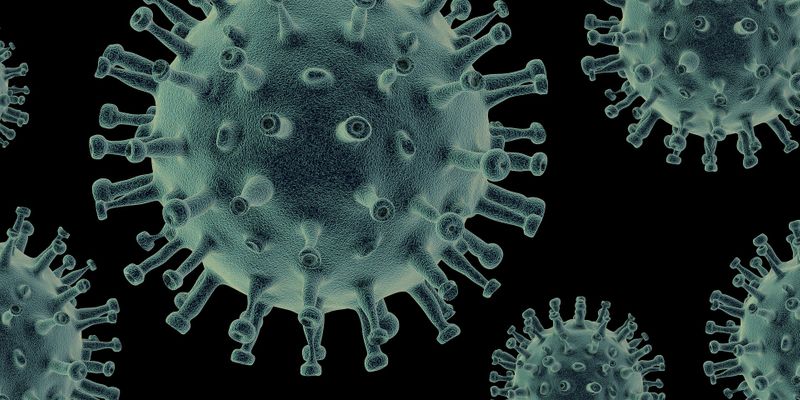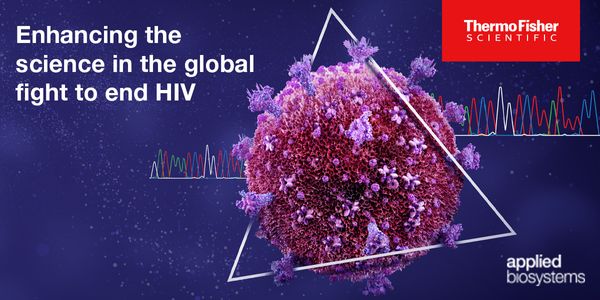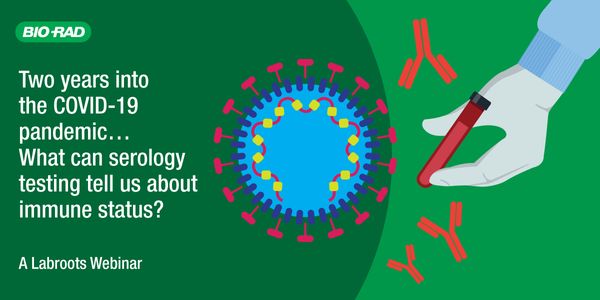Viral
The term viral refers to an infection driven by a virus and examples include COVID-19, AIDS, measles, hepatitis, and smallpox. Viruses contain DNA or RNA and must infect host cells in order to replicate and they can damage the host during this process. Antiviral medications or vaccines can treat viral infections.
-
OCT 20, 2022 | 11:00 AMDate: October 20, 2022 Time: 11:00am (PDT), 2:00pm (EDT), 8:00pm (CEST) Bacterial and viral infections produce a wide range of similar signs and symptoms leading often to the inappropriate u...OCT 19, 2022 | 10:30 AMLearning Objectives: 1. Discuss the methods used to diagnose COVID-19. 2. Define the preventive approaches to COVID-19. 3. Discuss the treatment strategies for COVID-19....OCT 19, 2022 | 9:45 AMSARS-CoV-2 spreads through airborne transmission. Aerosols containing live virus are dispersed when an infected person exhales and then continue to accumulate indoors, putting others at risk...OCT 19, 2022 | 6:00 AMCoronavirus Immunotherapeutic Consortium (CoVIC) is an international effort to conduct side-by-side, apples-to-apples comparisons of leading therapeutic antibody candidates against the SARS-...OCT 19, 2022 | 6:00 AMAt the end of 2019, severe acute respiratory syndrome coronavirus 2 (SARS-CoV-2), the causative agent of coronavirus disease 2019 (COVID-19), emerged in China. As of September 2022, SARS-CoV...SEP 29, 2022 | 8:00 AMDate: September 29, 2022 Time: 8:00am (PDT), 11:00am (EDT), 5:00pm (CEST) Adeno-associated virus (AAV) is one of the most widely used delivery vehicles in gene therapy. To ensure the safety...SEP 14, 2022 | 10:00 AMDate: September 14, 2022 Time: 10:00am (PDT), 1:00pm (EDT), 7:00pm (CEST) Virus-like particles (VLPs) are nanostructures that possess diverse applications in therapeutics, immunization, and...Speaker: John Tigges , James McCracken , Cecilia CavazzoniSponsored By: Beckman Coulter Life SciencesSEP 08, 2022 | 12:00 PMLoop-mediated isothermal amplification (LAMP) uses a stand-displacing DNA polymerase and four to six primers to rapidly amplify DNA at a single temperature. By eliminating temperature cyclin...Speaker: Ingrida Vendelė, PhD , Leann Buhrow, PhDSEP 07, 2022 | 3:00 PMPathogen detection and surveillance have become a high priority in both healthcare and environmental settings for the safety of patients and the general public. The COVID-19 pandemic highlig...Speaker: Dylan BarberaSEP 06, 2022 | 3:00 PMIn all organisms, innate immune pathways sense infection and rapidly activate potent immune responses while maintaining a high degree of specificity to prevent inappropriate activation (auto...AUG 30, 2022 | 1:00 AMDate: August 30, 2022 Time: 10:00am (CEST), 1:00am (PDT), 4:00am (EDT) Problem When it’s time for researchers to pick a protein or formulation, the best ones need to sweat it out at el...AUG 17, 2022 | 10:00 PMDate: August 18, 2022 Time: 3pm AEST | 1pm SGT | 2pm JP/KR Kirsten rat sarcoma viral oncogene homologue (KRAS) is the most frequently mutated oncogene, present in approximately 25% of tumors...AUG 16, 2022 | 7:00 AMDate: August 16, 2022 Time: 7:00am (PDT), 10:00am (EDT), 4:00pm (CEST) In this session, researchers, clinicians, and program implementers from four countries will address the disruption in co...Speaker: Carlos Brites, MD, PhD , Mandisa Dukashe, MPH, PhD(c) , Olabanjo Okunlola Ogunsola, MBCHB, MPH, FWACP , Dr. Cissy Kityo Mutuluuza, MBChB, M.Sc, PhD , Obiageli Okafor, MD, DrPH, MPH, ModeratorSponsored By: Thermo Fisher ScientificJUL 28, 2022 | 6:00 AMDate: July 28, 2022 Time: 6:00am (PDT), 9:00am (EDT) Hepatitis B and C continues to be a leading cause of global morbidity and mortality, resulting in 1.1 million deaths and 3 million new in...JUL 26, 2022 | 9:00 AMDate: July 26, 2022 Time: 9:00am (PDT), 12:00pm (EDT), 6:00pm (CEST) Organoids and spheroids are increasingly being used in many research applications, including drug discovery, toxicology,...JUN 29, 2022 | 8:00 AMDate: June 29, 2022 Time: 8:00am (PST), 11:00am (EST), 5:00pm (CEST) As of May 2022, there have been more than 500 million confirmed cases of COVID-19, including numerous variants. Additiona...Speaker: Anne-Geneviève Marcelin , Jean-François Mouscadet , Heidi ScholzSponsored By: Bio-Rad LaboratoriesJUN 22, 2022 | 8:00 AMBiopharmaceutical discovery, development and manufacturing requires the use of genetic analysis across the development continuum. Sanger sequencing and fragment analysis by capillary electro...JUN 16, 2022 | 7:00 AMDate: June 16, 2022 Time: 7:00am (PDT), 10:00am (EDT), 4:00pm (CEST) Lipid-based nanoparticles (LNPs) are effective non-viral vectors for delivering messenger RNA products (mRNA), most notab...JUN 07, 2022 | 10:00 AMDate: June 07, 2022 Time: 10:00am (PDT), 1:00pm (EDT), 7:00pm (CEST) On December 8th, 2021 the CDC released new recommendations for preexposure prophylaxis (PrEP) for the prevention of HIV i...JUN 01, 2022 | 9:00 AMDate: June 01, 2022 Time: 9:00am (PDT), 12:00pm (EDT), 6:00pm (CEST) The manufacturing process for cell and gene therapies is complex and can contain process-related impurities from multiple...MAY 24, 2022 | 9:00 AMDate: May 24, 2022 Time: 9:00am (PDT), 12:00pm (EDT), 6:00pm (CEST) Recent breakthroughs in autologous cellular therapies have generated tremendous excitement for the industry; however, thes...MAY 17, 2022 | 9:00 AMDate: May 17, 2022 Time: 9:00am (PDT), 12:00pm (EDT), 8:00pm (CEST) Gene therapeutics have great potential to treat many severe diseases in an unprecedented, targeted manner. The biopharmace...MAY 17, 2022 | 7:00 AMDate: May 17, 2022 Time: 7:00am (PDT), 10:00am (EDT), 4:00pm (CEST) Monoclonal antibody (mAb) is generated from a single clone of an antibody-producing cell and recognizes one specific epitop...MAY 04, 2022 | 3:00 PMThe severe acute respiratory syndrome coronavirus 2 (SARS-CoV-2) that emerged in late 2019 has spread globally, causing a pandemic of respiratory illness designated coronavirus disease 2019...Speaker: Arutha Kulasinghe, PhD
OCT 20, 2022 | 11:00 AM
Date: October 20, 2022 Time: 11:00am (PDT), 2:00pm (EDT), 8:00pm (CEST) Bacterial and viral infections produce a wide range of similar signs and symptoms leading often to the inappropriate u...
OCT 19, 2022 | 10:30 AM
Learning Objectives: 1. Discuss the methods used to diagnose COVID-19. 2. Define the preventive approaches to COVID-19. 3. Discuss the treatment strategies for COVID-19....
OCT 19, 2022 | 9:45 AM
SARS-CoV-2 spreads through airborne transmission. Aerosols containing live virus are dispersed when an infected person exhales and then continue to accumulate indoors, putting others at risk...
OCT 19, 2022 | 6:00 AM
Coronavirus Immunotherapeutic Consortium (CoVIC) is an international effort to conduct side-by-side, apples-to-apples comparisons of leading therapeutic antibody candidates against the SARS-...
OCT 19, 2022 | 6:00 AM
At the end of 2019, severe acute respiratory syndrome coronavirus 2 (SARS-CoV-2), the causative agent of coronavirus disease 2019 (COVID-19), emerged in China. As of September 2022, SARS-CoV...
SEP 29, 2022 | 8:00 AM
Date: September 29, 2022 Time: 8:00am (PDT), 11:00am (EDT), 5:00pm (CEST) Adeno-associated virus (AAV) is one of the most widely used delivery vehicles in gene therapy. To ensure the safety...
SEP 14, 2022 | 10:00 AM
Date: September 14, 2022 Time: 10:00am (PDT), 1:00pm (EDT), 7:00pm (CEST) Virus-like particles (VLPs) are nanostructures that possess diverse applications in therapeutics, immunization, and...
Speaker:
John Tigges
, James McCracken
, Cecilia Cavazzoni
Sponsored By: Beckman Coulter Life Sciences
SEP 08, 2022 | 12:00 PM
Loop-mediated isothermal amplification (LAMP) uses a stand-displacing DNA polymerase and four to six primers to rapidly amplify DNA at a single temperature. By eliminating temperature cyclin...
Speaker:
Ingrida Vendelė, PhD
, Leann Buhrow, PhD
SEP 07, 2022 | 3:00 PM
Pathogen detection and surveillance have become a high priority in both healthcare and environmental settings for the safety of patients and the general public. The COVID-19 pandemic highlig...
Speaker:
Dylan Barbera
SEP 06, 2022 | 3:00 PM
In all organisms, innate immune pathways sense infection and rapidly activate potent immune responses while maintaining a high degree of specificity to prevent inappropriate activation (auto...
AUG 30, 2022 | 1:00 AM
Date: August 30, 2022 Time: 10:00am (CEST), 1:00am (PDT), 4:00am (EDT) Problem When it’s time for researchers to pick a protein or formulation, the best ones need to sweat it out at el...
AUG 17, 2022 | 10:00 PM
Date: August 18, 2022 Time: 3pm AEST | 1pm SGT | 2pm JP/KR Kirsten rat sarcoma viral oncogene homologue (KRAS) is the most frequently mutated oncogene, present in approximately 25% of tumors...
AUG 16, 2022 | 7:00 AM
Date: August 16, 2022 Time: 7:00am (PDT), 10:00am (EDT), 4:00pm (CEST) In this session, researchers, clinicians, and program implementers from four countries will address the disruption in co...
Speaker:
Carlos Brites, MD, PhD
, Mandisa Dukashe, MPH, PhD(c)
, Olabanjo Okunlola Ogunsola, MBCHB, MPH, FWACP
, Dr. Cissy Kityo Mutuluuza, MBChB, M.Sc, PhD
, Obiageli Okafor, MD, DrPH, MPH, Moderator
Sponsored By: Thermo Fisher Scientific
JUL 28, 2022 | 6:00 AM
Date: July 28, 2022 Time: 6:00am (PDT), 9:00am (EDT) Hepatitis B and C continues to be a leading cause of global morbidity and mortality, resulting in 1.1 million deaths and 3 million new in...
JUL 26, 2022 | 9:00 AM
Date: July 26, 2022 Time: 9:00am (PDT), 12:00pm (EDT), 6:00pm (CEST) Organoids and spheroids are increasingly being used in many research applications, including drug discovery, toxicology,...
JUN 29, 2022 | 8:00 AM
Date: June 29, 2022 Time: 8:00am (PST), 11:00am (EST), 5:00pm (CEST) As of May 2022, there have been more than 500 million confirmed cases of COVID-19, including numerous variants. Additiona...
Speaker:
Anne-Geneviève Marcelin
, Jean-François Mouscadet
, Heidi Scholz
Sponsored By: Bio-Rad Laboratories
JUN 22, 2022 | 8:00 AM
Biopharmaceutical discovery, development and manufacturing requires the use of genetic analysis across the development continuum. Sanger sequencing and fragment analysis by capillary electro...
JUN 16, 2022 | 7:00 AM
Date: June 16, 2022 Time: 7:00am (PDT), 10:00am (EDT), 4:00pm (CEST) Lipid-based nanoparticles (LNPs) are effective non-viral vectors for delivering messenger RNA products (mRNA), most notab...
JUN 07, 2022 | 10:00 AM
Date: June 07, 2022 Time: 10:00am (PDT), 1:00pm (EDT), 7:00pm (CEST) On December 8th, 2021 the CDC released new recommendations for preexposure prophylaxis (PrEP) for the prevention of HIV i...
JUN 01, 2022 | 9:00 AM
Date: June 01, 2022 Time: 9:00am (PDT), 12:00pm (EDT), 6:00pm (CEST) The manufacturing process for cell and gene therapies is complex and can contain process-related impurities from multiple...
MAY 24, 2022 | 9:00 AM
Date: May 24, 2022 Time: 9:00am (PDT), 12:00pm (EDT), 6:00pm (CEST) Recent breakthroughs in autologous cellular therapies have generated tremendous excitement for the industry; however, thes...
MAY 17, 2022 | 9:00 AM
Date: May 17, 2022 Time: 9:00am (PDT), 12:00pm (EDT), 8:00pm (CEST) Gene therapeutics have great potential to treat many severe diseases in an unprecedented, targeted manner. The biopharmace...
MAY 17, 2022 | 7:00 AM
Date: May 17, 2022 Time: 7:00am (PDT), 10:00am (EDT), 4:00pm (CEST) Monoclonal antibody (mAb) is generated from a single clone of an antibody-producing cell and recognizes one specific epitop...
MAY 04, 2022 | 3:00 PM
The severe acute respiratory syndrome coronavirus 2 (SARS-CoV-2) that emerged in late 2019 has spread globally, causing a pandemic of respiratory illness designated coronavirus disease 2019...
Speaker:
Arutha Kulasinghe, PhD
























